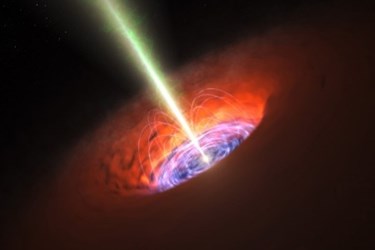Hubble Glimpses Birth Of A Black Hole
By Jof Enriquez,
Follow me on Twitter @jofenriq

Astronomers reviewing data collected by the Hubble Space Telescope claim to have caught a glimpse of the birth of a black hole formed from a dying star.
Hubble first observed the supergiant star N6946-BH1, which is 20 million light years from Earth, in 2004 when it was calculated to be about 25 times more massive than the Sun. In 2009, astronomers found out that the star flared a million times brighter than our sun for a few months before fading.
The findings were consistent with a common theory about black hole formation. When giant stars reach the final stage of their life cycle as they run out of hydrogen fuel, they explode in a supernova casting off many neutrinos. Then, electrons reattach to the hydrogen ions that float around it, giving birth to a black hole. It collapses in upon itself due to the inward pull of gravity so great that not even light can escape.
“It’s an exciting result and long anticipated,” said Stan Woosley at Lick Observatory in California, according to New Scientist.
“This may be the first direct clue to how the collapse of a star can lead to the formation of a black hole,” Avi Loeb at Harvard University, who was not a member of the research team, told the publication.
The brief flare emitted by N6946-BH1 in 2009 could be the result of the star ejecting its neutrinos. Newer images indicate that the star is no longer emitting visible wavelength light, but a fainter source in the same spot is detectable in the infrared, as a warm afterglow.
Other possibilities for the star's disappearance, such as a stellar merger would have caused an even brighter flare-up, and dust wouldn't hide it from Hubble's view for so long. A black hole is the most likely explanation, say the researchers.
"The event is consistent with the ejection of the envelope of a red supergiant in a failed supernova and the late-time emission could be powered by fallback accretion onto a newly-formed black hole. Future IR and X-ray observations are needed to confirm this interpretation of the fate for the star," astrophysicists S. M. Adams, C. S. Kochanek, J. R. Gerke, K. Z. Stanek, X. Dai, wrote in the scientific pre-print website arXiv.org.
Astronomers from Johns Hopkins University, NASA, and the Rochester Institute of Technology proved in 2013 that gas spiraling toward a black hole inevitably results in X-ray emissions. The largest X-ray flare ever emitted from the supermassive black hole at the center of the Milky Way galaxy was detected by NASA's Chandra X-ray Observatory in January 2015.
The astronomers plan to use the same observatory to obtain new data on N6946-BH1 in the next couple of months to confirm their findings on the star's transformation into a black hole.
